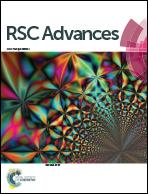Stabilization of arsenic in waste slag using FeCl2 or FeCl3 stabilizer
Abstract
With the aim of stabilizing arsenic pollution in mine tailing, FeCl2 and FeCl3 were chosen as stabilizers. The changes in pH, speciation, and leaching concentration of arsenic were analyzed. The stabilization mechanism of the FeCl2 and FeCl3 stabilizers towards the removal of arsenic has been discussed based on FTIR spectroscopy and XRD results; the results show that both the FeCl2 and FeCl3 stabilizers can reduce the pH of arsenic waste slag, but pose the risk of acidification, especially for FeCl3. Both stabilizers could reduce the content of acid-soluble arsenic. When the Fe : As molar ratio was 1.0 and an FeCl2 mixed solution at pH = 7 and FeCl3 mixed solution at pH = 4 and pH = 7 were used, the acid-soluble arsenic was decreased by 96.22%, 93.42%, and 96.22%, respectively. The arsenic leaching concentration <2.5 mg L−1, which meets the minimum requirements for the entrance of safe landfill sites, demonstrates that the FeCl2 and FeCl3 stabilizers have good stabilizing effects. The acid-soluble arsenic or reducible arsenic can be converted into residual arsenic by the FeCl2 stabilizer. Furthermore, acid-soluble arsenic was converted into residual arsenic and oxidized arsenic by the FeCl3 stabilizer.



 Please wait while we load your content...
Please wait while we load your content...